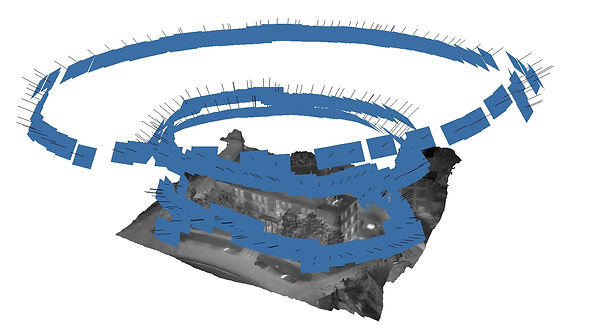VAMPIRE:
Fast Radiative Heat Analysis

ROLE
Student Researcher and Primary Author
DESCRIPTION
Developing an end-to-end method for estimating the radiative heat loss from structures in the built-environment.
The Problem
There are limited ways to estimate the radiative heat loss from a building's surface (envelope). With the growing threat of climate change pushing for more sophisticated ways of improving energy efficiency in buildings, I collaborated with two research professors and other students to design an end-to-end workflow for obtaining the total radiative heat loss from a structure.
The Solution
Our method, dubbed VAMPIRE uses drones outfitted with thermal cameras, surface-from-motion photogrammetry, and numerical surface integration software I designed to process thermal OBJ files.
Mark Leggiero, Bradley Andrew, Ryan Elliott, John Indergaard, J.B. Sharma, Thomas Vogel, Radiative heat loss estimation of building envelopes based on 3D thermographic models utilizing small unmanned aerial systems (sUAS), Energy and Buildings, Volume 244, 2021, 110957, ISSN 0378-7788, https://doi.org/10.1016/j.enbuild.2021.110957.
For a written summary of my work... I published a paper in the journal "Energy and Buildings"
I was the primary author of a publication on this project, cited below. Feel free to download the full text for further details on the theory and developed methodology:
My work on VAMPIRE:

DJI Inspire 1 drone outfitted with Zenmuse XT 1 thermal imager was primarily used for image collection. (Source: DJI)
Agisoft Metashape photogrammetry software was utilized to generate 3D thermal models using thermal images and tagged drone positions.


Researched flight paths, view angles, and image overlap for optimal thermographic model creation
Due to the novelty of the use of thermal imagery for 3D model creation, preliminary work was required to recommend a method for capturing thermal images while retaining temperature accuracy and model detail.
Measurements were conducted in the mornings and involved leading a team of fellow students and certified drone operator to acquire ambient measurements around structures and thermal images.
Created software to discretize building thermal models and perform surface numerical integration
Through utilizing the file structure of the OBJ file type, temperature data from the thermal images, and spatial data from the 3D model were extracted and processed using the numerical integration algorithm shown below. A GUI in MATLAB was developed to streamline processing.
Feel free to download the software for further inspection:

3D thermal model of the Rogers Building on the University of North Georgia's Dahlonega campus.

Numerical surface integration
algorithm for OBJ files
